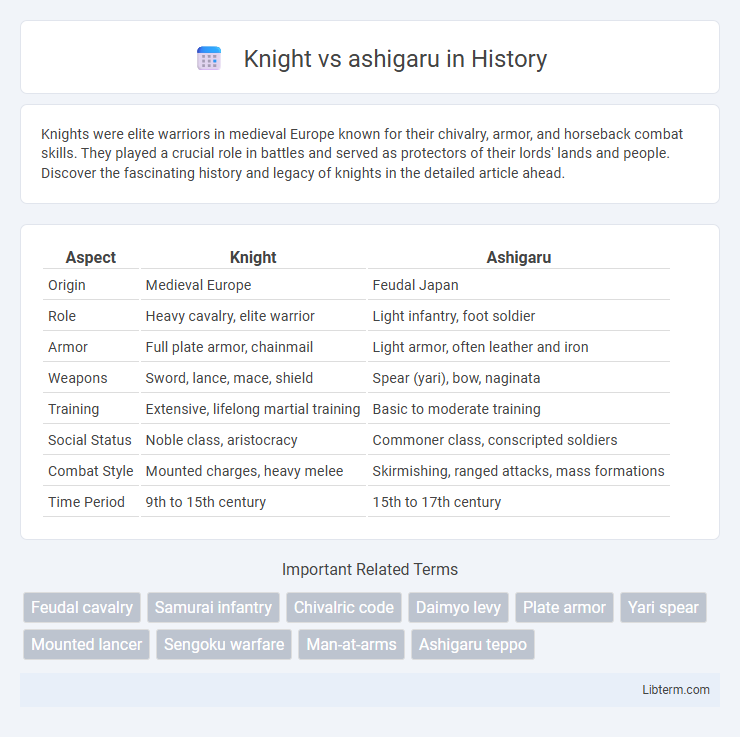Knights were elite warriors in medieval Europe known for their chivalry, armor, and horseback combat skills. They played a crucial role in battles and served as protectors of their lords' lands and people. Discover the fascinating history and legacy of knights in the detailed article ahead.
Table of Comparison
| Aspect | Knight | Ashigaru |
|---|---|---|
| Origin | Medieval Europe | Feudal Japan |
| Role | Heavy cavalry, elite warrior | Light infantry, foot soldier |
| Armor | Full plate armor, chainmail | Light armor, often leather and iron |
| Weapons | Sword, lance, mace, shield | Spear (yari), bow, naginata |
| Training | Extensive, lifelong martial training | Basic to moderate training |
| Social Status | Noble class, aristocracy | Commoner class, conscripted soldiers |
| Combat Style | Mounted charges, heavy melee | Skirmishing, ranged attacks, mass formations |
| Time Period | 9th to 15th century | 15th to 17th century |
Historical Background: Knights and Ashigaru
Knights were heavily armored cavalry soldiers in medieval Europe, emerging during the High Middle Ages around the 9th century and playing a pivotal role in feudal warfare and society. Ashigaru were foot soldiers in feudal Japan, initially lightly armed peasants who evolved into a more organized infantry force by the Sengoku period (15th-17th centuries), equipped with spears, arquebuses, and later firearms. Both served as essential military classes within their respective feudal systems but differed significantly in armor, tactics, and social status.
Origins and Social Status
Knights originated from the medieval European feudal system, serving as heavily armored cavalry tied to noble lineage and land ownership, symbolizing elite warrior status and chivalric ideals. Ashigaru, emerging in feudal Japan during the Muromachi period, were foot soldiers recruited primarily from peasant backgrounds, reflecting a lower social rank but playing crucial roles in large-scale battles. The stark contrast in origin and social hierarchy highlights knights as aristocratic warriors while ashigaru represented the common warrior class within their respective cultures.
Armor and Weapons Comparison
Knights typically wore heavy plate armor, providing extensive protection against both melee and projectile weapons, while ashigaru relied on lighter armor such as leather or iron plates for mobility. Knights wielded swords, lances, and maces designed for close combat and mounted warfare, whereas ashigaru primarily used yari spears and yumi bows optimized for infantry roles and ranged attacks. The disparity in armor and weapons underscored the knight's role as heavily armored cavalry contrasted with the ashigaru's function as versatile, lightly equipped foot soldiers.
Training and Discipline
Knights underwent rigorous and prolonged training from childhood, focusing on horsemanship, swordsmanship, and chivalric codes, fostering a highly disciplined warrior elite. Ashigaru soldiers received more basic and practical military training, often starting as local conscripts with limited combat skills refined primarily in group tactics and spear use. The difference in training intensity and discipline reflected their distinct social statuses and battlefield roles in feudal Japan.
Battlefield Roles and Tactics
Knights dominated medieval European battlefields as heavily armored cavalry, specializing in shock combat and breaking enemy lines with their powerful charges and close-quarters combat skills. Ashigaru, as Japanese foot soldiers, fulfilled versatile roles including spear and bow units, excelling in coordinated formations and supporting samurai with massed infantry tactics that emphasized mobility and ranged harassment. While knights relied on individual combat prowess and armored protection, ashigaru utilized strategic positioning, disciplined spear formations, and combined arms approaches to overwhelm enemies through coordination and adaptability.
Leadership and Chain of Command
Knights operated within a strict hierarchical structure emphasizing personal honor and direct command over their retinues, whereas ashigaru functioned under a more centralized and rigid military chain of command led by samurai officers. The leadership of knights was often decentralized, relying on individual prowess and feudal obligations, contrasting with the ashigaru's disciplined adherence to orders from daimyo and samurai commanders. Command efficiency in ashigaru units enabled coordinated mass movements, while knight forces excelled in autonomous tactical decisions driven by their leadership's battlefield experience.
Cultural and Philosophical Differences
Knights embodied the chivalric code emphasizing honor, loyalty, and martial prowess as a reflection of feudal European aristocratic values, often tied to Christianity and knighthood rituals. Ashigaru, as foot soldiers in feudal Japan, operated within a Confucian and Bushido-influenced framework prioritizing discipline, collective duty, and adaptability over individual glory. These cultural and philosophical distinctions underscored divergent approaches to warfare, social hierarchy, and spiritual meaning between the medieval European and Japanese warrior classes.
Impact on Warfare in Europe and Japan
Knights in medieval Europe and ashigaru in feudal Japan significantly shaped warfare by emphasizing different modes of combat and military organization. European knights, heavily armored cavalry, established dominance through shock tactics and chivalric codes, influencing feudal hierarchies and battlefield strategies. Ashigaru, equipped with spears and arquebuses, enabled mass infantry mobilization and flexible tactics, transforming Japanese warfare by reducing the prominence of mounted samurai and fostering centralized military power.
Legacy in Modern Popular Culture
Knights and ashigaru symbolize contrasting medieval warrior classes that continue to shape modern popular culture through films, literature, and video games. Knights embody chivalry, honor, and medieval European valor, inspiring characters in fantasy and historical narratives, while ashigaru represent the disciplined, strategic foot soldiers of feudal Japan, influencing samurai stories and role-playing genres. Their legacies underscore cultural ideals of bravery and discipline, bringing historical authenticity and rich storytelling to contemporary media worldwide.
Myth vs Reality: Separating Fact from Fiction
Knights often symbolize heavily armored, elite warriors, while ashigaru were foot soldiers with lighter armor, but both played crucial roles in medieval Japanese warfare. Contrary to popular myths, ashigaru were not mere peasants but trained soldiers who could impact battles significantly, sometimes even defeating knights in certain conditions. Historical evidence shows that the effectiveness of ashigaru against knights depended on tactics, terrain, and weaponry rather than a simple clash of skill or status.
Knight Infographic

 libterm.com
libterm.com